Best of India Tours
- Golden Triangle Tour- Best of India & Nepal
- Classical Rajasthan
India Cultural Tours
- Images of North India- Karnataka Heritage
- Rajasthan & Goa Tour
Discover India Tours
- Grand India Tour- North to South India
- Central to South India
Rajasthan Tours
- Classical Rajasthan Tour- Golden Triangle Tour
- Grand Mughal Tour
India Luxury Trains
- Palace on Wheels- The Golden Chariot
- India Deccan Odyssey
- The Indian Maharaja
- Royal Rajasthan on Wheels
Nepal Tours
- Glimpses of Nepal- Buddhist Pilgrimage
- Nepal River Rafting
- Destinations of Nepal
- Nepal General Info
India Wildlife Tours
- North India Wild Life- South India Wildlife
Tibet Tours
- Tibet Monastery Tours- Explore Tibet
- Destinations of Tibet
Spa & Yoga Tours
- Ananda in Himalayas- Yoga & Meditation
Adventure Tours
- Manali Safari Tour- Himalayan Trekking
- Horse Safari
Varanasi
Agra
![]() Allahabad
Allahabad
![]() Auli
Auli
![]() Badrinath
Badrinath
![]() Corbett
Corbett
![]() Kushinagar
Kushinagar
![]() Lucknow
Lucknow
![]() Nainital
Nainital
![]() Varanasi
Varanasi
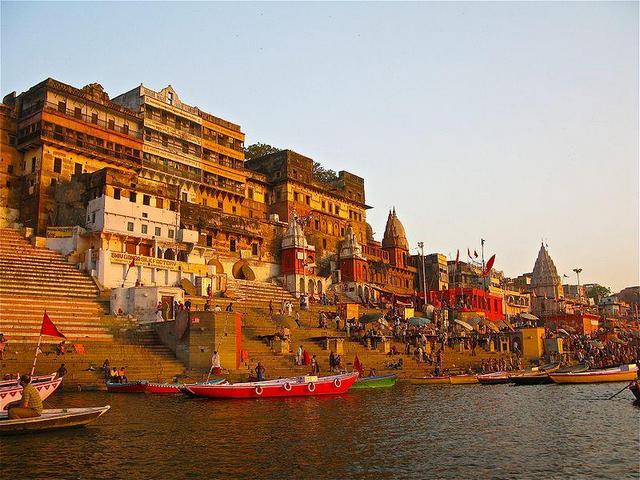
The city of Varanasi is situated along the west bank of the Ganges in the north Indian state of Uttar Pradesh. Called Benaras by the British, Varanasi is an important pilgrimage centre for the Hindus. The city finds mention in the great epics of Mahabharata and Ramayana. It was a flourishing trade center when Buddha came to Sarnath, about 10 kilometres away, to preach his first sermon in 500 BC. The renowned American novelist Mark Twain once wrote, Benaras is older than history, older than tradition, older even than legend and looks twice as old as all of them put together.
Right from the ancient times, Varanasi has stood as a symbol of Hindu renaissance and preserved the rituals and traditions of Hindu philosophy. Down the ages, pilgrims from distant lands have come to Varanasi in search of divine blessings. Summers can be quite harsh in Varanasi with the temperatures going up to 45°C. The monsoon season, which starts by late June or early July, brings in the torrential rains and high humidity. Winters are quite pleasant with temperatures remaining at around 20°C in the day. However, the early part of the day can remain enveloped in the fog.
Sightseeing
Temples form the major source of attraction in this ancient city. The banks of the Ganges, considered to be a sacred river by the Hindus, are the centre of much of the religious activity that occurs in the city. The ghats built along the banks of the river for such religious activity also form a major source of attraction here. Some of the other interesting places to visit around the city are Alamgir Mosque, Durga Temple, Vishwanat Temple, Bharat Mata temple, Tulsi Manas Temple, Banaras Hindu University and the Archaeological Museum.
Excursions
Excursions around Varanasi get you further acquainted with the mystic religion of Hinduism besides presenting an insight into the Buddhism. A visit to Sarnath, Bodhgaya and Kushinagar puts you on the trail of Buddha from the period of his attaining enlightenment to his passing away. Allahabad and Ramnagar Fort are the other places around Varanasi that are worth a visit.
Excursions for Varanasi
River Front
The long string of ghats the chain of stone steps along the western bank of the Ganges forms the major attraction of Varanasi. There are about hundred ghats in the city and each of them is marked by a lingam and occupies its own special place in the religious geography of the city. The ghats, though some of them have crumbled over the years, continue to thrive with early-morning bathers, Brahmin priests offering puja and people practicing meditation and yoga. Though most of the ghats are used for bathing, there are two ’burning ghats’ Manikarnika Ghat & Harishchandra Ghat were bodies are cremated. The pilgrims here are supposed to bathe at five special ghats in a sequence during a ritual called the Panchatirthi Yatra. For the casual visitor however the easiest way to see the ghats is to follow a south-north sequence either by boat or on foot.
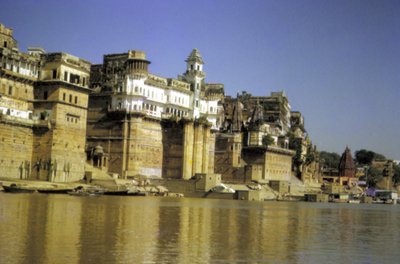
Alamgir Mosque
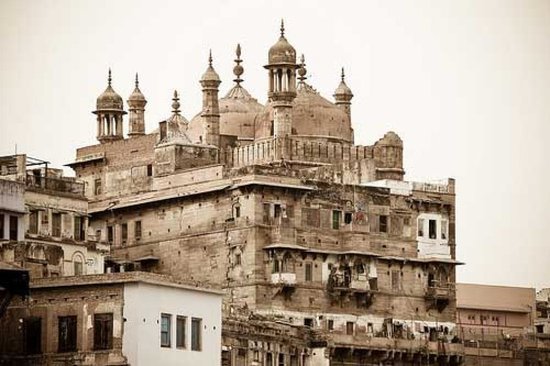
Also known as Beni Madhav Ka Darera, the Alamgir Mosque is a blend of the Hindu and Mughal styles of the architecture. The mosque, built by Aurangzeb on the site of the Vishnu Temple, overlooks the Panchganga Ghat.
Durga Temple
Located 2 kilometres south of the old city, this eighteenth century Durga Temple is also known as the Monkey Temple due to many aggressive monkeys that reside here. The temple was built in a common north Indian style with an ornate shikhara, consisting of five segments symbolizing the elements and supported by finely carved columns. Here Durga is represented as the embodiment of shakti or female power, clad in red and riding a tiger and fully armed with Shiva’s trident, Vishnu’s discus and a sword. A forked stake in the courtyard was used during festivals in the earlier times to behead sacrificial goats. The ritual of sacrifice has now been replaced by a symbolic mark in vermilion. Non-Hindus are admitted to the courtyard but not the inner sanctum.
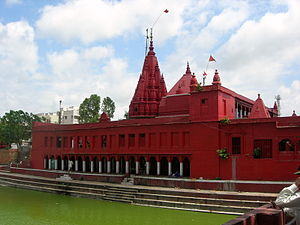
Vishwanath Temple
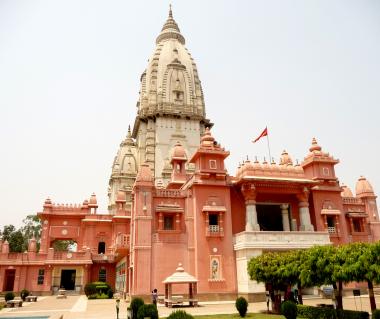
The temple is located in the premises of the Banaras Hindu University and is about thirty minutes walk from the gates of the university. The temple, built by the Birlas, was planned by Pandit Madan Mohan Malaviya. Unlike many other temples in Varanasi, this temple is open to all irrespective of caste or creed.
Bharat Mata Mandir
This temple of Bharat Mata (Mother India), inaugurated by Mahatma Gandhi, lies about 3 kilometres west of Godaulia, outside the old city. Here, instead of gods and goddesses, one finds a huge relief map in marble of the whole of Indian subcontinent and Tibetan plateau. The map is said to be perfectly to scale both vertically and horizontally with mountains, rivers and the holy tirthas (pilgrimage centers) all clearly visible.at five special ghats in a sequence during a ritual called the Panchatirthi Yatra. For the casual visitor however the easiest way to see the ghats is to follow a south-north sequence either by boat or on foot.

Tulsi Manas Temple
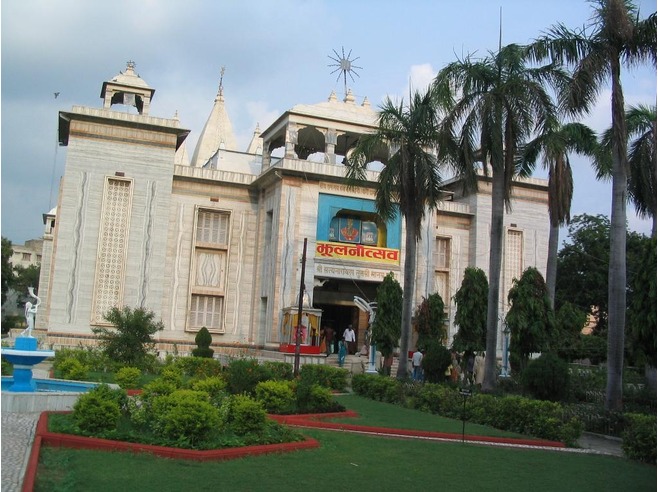
Built in 1964, the Tulsi Manas Temple stands about 150 m south of Durga Temple. The temple, dedicated to Lord Rama is situated at the place where Tulsidas, the great medieval seer, is believed to have lived and written the great epic ” Shri Ramcharitmanas”. The two tier walls of the temple are engraved with the verses and scenes from this great epic.
Banaras Hindu University
One of the oldest educational centres in India, the Banaras Hindu University was built in 1917. The university was founded by Pandit Madan Mohan Malviya as a centre for the study of Indian art, culture, music and Sanskrit. The university campus is spread over five square kilometres and houses the Bharat Kala Bhavan. The Bhavan has a fine collection of miniature paintings, sculptures from first to fifteenth centuries, old photographs of Varanasi and brocade textiles. The campus also houses the New Vishwanatha Temple.
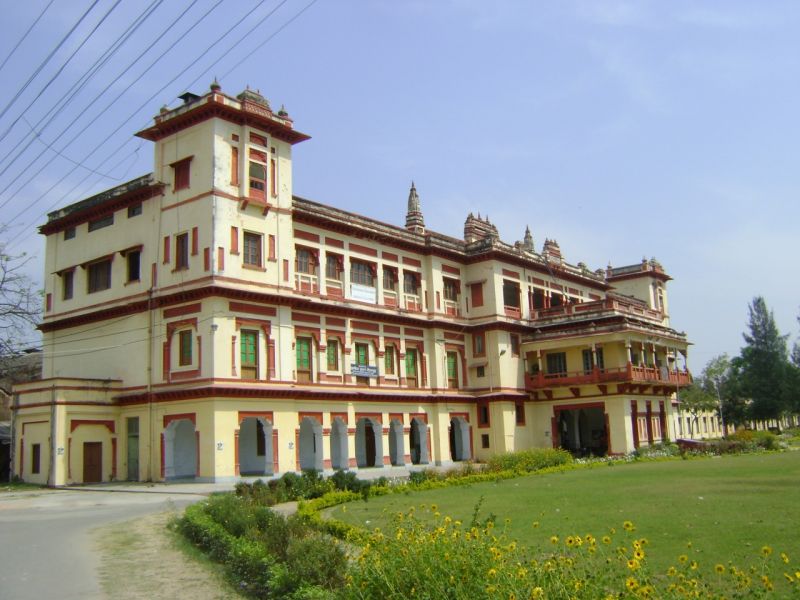
Museum
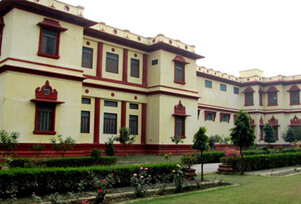
Located in Sarnath at about 10 km from Varanasi, the Archaeological Museum houses the capital from the Ashokan pillar, the symbol of which has been adopted as the state emblem of the modern India. The museum also has the figures and the sculptures from the Mauryan, Kushana and Gupta periods discovered during the excavations at Sarnath. You can have a look at the earliest Buddha image found at Sarnath and many images of Hindu Gods dating from the 9th to 12th centuries.
Allahabad
One of the holiest cities of India, Allahabad is situated at a distance of about 135 km west of Varanasi and 238 km from the state capital Lucknow. This ancient city finds mention in the Vedas, Puranas, the Ramayana and the Mahabharata, as Prayag. Allahabad stands at the confluence of two of India’s holiest rivers, the Ganga and the Yamuna. The confluence called the Sangam, is the venue of many sacred fairs and rituals and attracts thousands of pilgrims throughout the year. The present city was founded in 1575 by the great Mughal ruler Allahabad Akbar who gave it a name of `Illahabas’. It was he who built a magnificent fort on the banks of the holy Sangam.

The city, which has been the hometown or the adopted town of many eminent personalities of the country, is quite an interesting and relaxing place to visit.
Bodhgaya
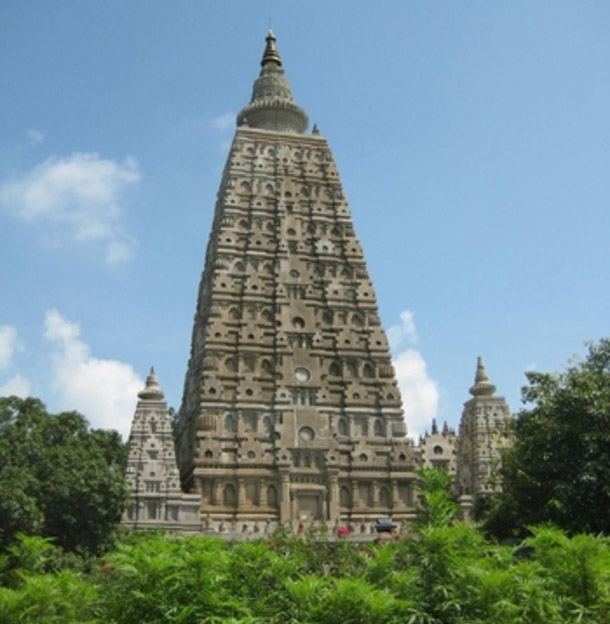
Located in the state of Bihar, Bodhgaya along with Sarnath and Kushinagar are the most sacred places for the Buddhists around the country. It is here in Bodhgaya that Buddha is supposed to have attained enlightenment under the Bodhi Tree. The tree from the original sapling still stands in the temple premises The magnificent Mahabodhi temple stands adjacent to this bodhi tree. The temple stands on the site of the ancient temple erected by Ashoka in the 3rd century BC. The inscriptions here describe the visits of pilgrims from Sri Lanka, Myanmar and China between 7th and 10th century AD
Kushinagar
About 51 kilometres from Gorakhpur lies Kushinagar, a place famous for the Mahaparinirvana (death) of Lord Buddha. The town, once a celebrated center of the Malla kingdom, has many of the stupas and viharas that date back to 230 BC–413 AD. One of the important sites to see here is the Mahaparinirvana Temple, where you can find the famous reclining statue of Buddha. The 20-feet-long statue is seated on a brick platform. Around the temple, one can find the ruins of as many as eight monasteries.

Ramnagar Fort

This 17th century fort is the home of the former Maharaja of Banaras. The fort lies at a little distance to the south of the Asi Ghat. You can have an impressive view of the fort from the other side of the river. It can be reached by a road heading south from the Banaras Hindu University and over a rickety pontoon bridge. During the monsoon, the area is accessible by a ferry. The museum inside the fort houses a collection that includes horse-drawn carriages, old motor cars, gilded and ornate silver howdahs (elephant seats), hookahas, costumes, a collection of minute ivory carvings, an astronomical clock, hunting trophies, vintage silver and brocade palanquins, a replica of the royal bed and an armoury of swords and guns.
Ksarnath
A major Buddhist centre, Sarnath lies 10 kilometres north east of Varanasi. It was here that Buddha preached his message of the ’middle way’ to nirvana after achieving enlightenment at Bodhgaya. In around 234 BC, Emperor Ashoka, a great follower of Buddhism, erected a stupa here. Between the 3rd century BC and the 11th century AD, several Buddhist structures were built here in Sarnath. Most of the Sarnath’s monuments are set in large gardens making it quite pleasant for a visitor to spend some time here . The Buddha Purnima festival is held here in May to celebrate the birth of Lord Buddha.
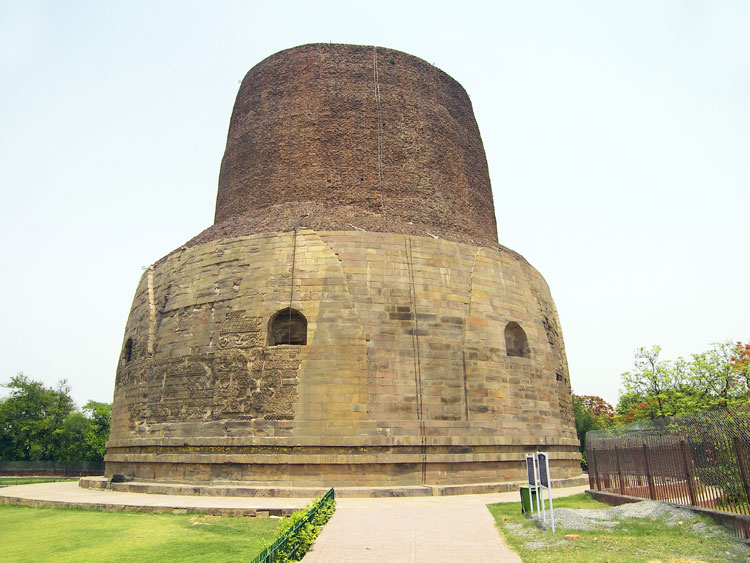
Fact File
 Area: 83.05 sq km
Area: 83.05 sq km
 Population:2.5 million
Population:2.5 million
 Altitude: 80.71 m
Altitude: 80.71 m
 Best Time to Visit:October-March
Best Time to Visit:October-March
 Languages:Bhojpuri ; Hindi & English
Languages:Bhojpuri ; Hindi & English
 STD Code: 0542
STD Code: 0542




